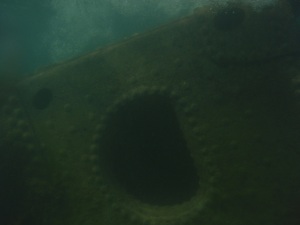Hyposmocoma is not the only unusual group of moth caterpillars I failed to observe in Hawai`i. Oh no precious, they are not.
Everyone knows what an inchworm looks like. Inchworms are the caterpillars of a family of moths called, appropriately, geometer moths. They tend to be well-camouflaged, resembling twigs. They eat plants, like most caterpillars, and some are serious agricultural pests.
A handful of Hawaiian species of the genus Eupithecia decided to break with tradition and become carnivores. They take advantage of their camouflage to fool unsuspecting insects into stepping on them. Then they suddenly reach back, grab the interloper with their talon-shaped legs, and eat it.
What’s especially cool is that they are not visual hunters. One species, in fact, hunts in the dark. Instead, they respond to touch: sensitive hairs on their backs tell them when prey is within striking distance. An insect walking on the caterpillar’s head or the front two thirds of its body will be unharmed.
It has been suggested, but not tested, that carnivorous Eupithecia‘s prey capture technique evolved from the “strike response” seen in some herbivorous caterpillars. The behaviour is best studied in the tobacco hornworm (Manduca sexta), the larva of a large sphinx moth. When something brushes against it, it reaches back and sometimes rasps its mouthparts against its skin. This behaviour could serve to startle birds that attempt to eat a hornworm, or to remove parasitoid wasps that would lay their eggs on it (and whose larvae would then eat the caterpillar alive).
By this point you should be dying of curiosity. You want to see these caterpillars in action, don’t you? Well fortunately, the BBC has delivered this nightmarish footage. And io9’s got your animated gif needs covered. Wicked, eh?
I’m going to end this post on a somber note, though. Carnivory by Hawaiian Eupithecia was discovered in the 1970s. The discoverer, Steven Montgomery, described a later foray to the site where he first found a caterpillar chewing on a fly. His report struck a chord with me, calling to mind my own impressions of the Hawaiian rainforest—and this paper is from 1983.
I recently returned to the volcanic cone on the Big Island where I first learned that Hawaii’s caterpillars were insect killers. After 10 years, I was keen to see if the endangered lobelia-like plants still found sanctuary in the steep cinder cone, because a carelessly set fire had destroyed the only other clump of these stately wonders. As I climbed the steep slope, I was stung on the head by a yellowjacket, a recently arrived pest that apparently stole into the Islands with cargo from the mainland. Rounding the top, I searched in vain for the lobelias. With them, half of the native forest plants had disappeared, and signs of rooting by pigs were frequent. Suddenly, a large European boar charged from under the koa tree and fled. I found no caterpillars that day, and heard few native birds. For this place, a conservation opportunity has passed, but on behalf of other Hawaiian forests, it teaches us what is at stake.
These species are not listed as endangered, but their habitat is dwindling; like many endemic Hawaiian species, their days may be numbered.
References
Montgomery, Steven L. (1983). Carnivorous caterpillars: the behavior, biogeography and conservation of Eupithecia (Lepidoptera: Geometridae) in the Hawaiian Islands GeoJournal, 7 (6), 549-556 DOI: 10.1007/BF00218529
van Griethuijsen LI, Banks KM, & Trimmer BA (2013). Spatial accuracy of a rapid defense behavior in caterpillars. Journal of Experimental Biology, 216 (Pt 3), 379-387 PMID: 23325858





